[one_half]
[/one_half][one_half_last]
[/one_half_last]
Buy a Talon on GunsAmerica: https://www.gunsamerica.com/Search.aspx?T=nighthawk%20talon
Read more about the Talon: https://www.nighthawkcustom.com/pistols/talon-series
Read about Sig’s .38 Super ammo: https://www.gunsamerica.com/blog/sig-38-super-ammunition-test/
Read a Review of a Night T4: https://www.gunsamerica.com/blog/nighthawk-t4/
Starting out
I have a Nighthawk Custom 1911 Talon in 9mm that I have owned since 2010. I have upgraded the Talon every year or two since purchasing it. I might add the one-piece mag well/main spring one year, and upgrade to a pair of Heinie sights the next. These small changes aren’t necessarily restricted to a yearly event–those G 10 grips and grip screws just couldn’t wait! In 2016, I knew it was time to make the biggest improvement yet: I was going to add a caliber to the gun.
The Thought Process
We all have things that draw us to a particular platform or caliber of gun. Get enough gun people in a room with some coffee, and you are guaranteed to hear the words “I wish they still made…”, “…was the perfect caliber” or “I don’t know why it went away!” at least one time in conversation.
My nostalgic point for the full-size 1911 has always been the .38 Super. I recently wrote an article on this caliber, in which I set out to answer some common question: is it obsolete, and why did it go away in the first place? The reason the .38 Super is such a sweet spot for the 1911 platform is that it was designed specifically for the 1911, to optimize its round count while maximizing reliability and power. I’m not aware of any other round, including the .45 ACP, that can lay claim to this exact design intent. In a full size 1911, you can get 10+1 of .38 Super, rounds that feeds reliably as the case length matches that of the 45 ACP.
When you consider the increased velocity of the .38 Super over the 9mm, it’s easy to understand why I want it! The only problem with this desire is justifying the price of a new 1911 in .38 Super. Because I’ve always got to look out for Number One, I quickly went about finding a way to scratch that itch in a more affordable manner. This quest led me to the workbench of Bob Reeves- Gunsmith at Nighthawk Custom in Berryville, Arkansas. Bob assured me that the conversion would be a relatively straightforward process, and affordable when compared to the cost of a new firearm.
The Conversion Process
When Bob and I began talking about this project, I laid out my exact goal for the end product. Simply put, I wanted my Nighthawk Talon to be 100% as reliable in .38 Super as it had been in 9mm. Since my gun was built from the ground up for 9mm, with a ramped barrel, the conversion process would be relatively straightforward and yield good results. Bob was able to get started on my gun quickly, which I sure appreciated (thanks Bob!). All told, it took about six weeks. The total price for the project was going to be about $550.00 plus tax (at least, that’s what I told myself).
[full_width]
[/full_width]
Because I live close to Berryville, I decided to drop my gun off with Bob. While we were looking the gun over, I decided to add a full-length guide rod with the Ever Last Recoil System (designed by Bob Marvel). Bob noticed that my ejector appeared to be cracked, so–out of an abundance of caution–I decided to add a new ejector. With these two additions I was now looking at just over $700 plus tax, still relatively inexpensive when compared to the price of a new Nighthawk Custom 1911.
Parts/Labor
- Stainless 38 Super Barrel & Bushing $339.95
- 38 Super Extractor ($60.00 w/out Checkering) $95.00
- 38 Super Ejector (mine was broken) $75.00
- 2 Chip McCormick 10 Round 38 Super Magazines $73.98
- Ever Last Recoil System (New spring only 15.00) $99.50
- Test Fire Fee $40.00
Following the inspection and defining the work to be done, Bob stripped the slide of the gun down. The barrel and bushing had to be fitted to the slide, a process involving three key areas. The barrel hood must be fitted to the breach of the slide. The barrel bushing must hold the front of the barrel securely to the front of the slide, but still allow it to unlock and slide. Finally, the feet of the barrel must be cut and a link installed to position the barrel to the frame. If any of these tasks are not done properly, the resulting gun will either fail to function reliably, or will deliver poor accuracy. The barrel is then painted with Dykem Steel Blue Layout Fluid, and then the skill of a master gunsmith is applied to remove metal from the oversized parts. This is not done with power tools, but rather with files and sand paper.
[full_width]
[/full_width]
Once the barrel is fitted, the extractor must be fitted as well. The hook that slides over the seated round in the barrel is cut. The extractor is also a spring, and must be calibrated to ensure extraction without impeding feeding. Finally, the rear of the extractor must be trimmed and checkered to match the rear of the slide.
In my case, the ejector was replaced along with the firing pin stop. The ejector is pinned, and must be fitted to ensure it will eject the spent round without hitting the magazine feed lip. The rear must also be trimmed so that it does not extend past the rear of the slide. The firing pin stop requires some minor fitting to fit in the slide and be retained by the extractor.
[one_half]
[/one_half][one_half_last]
[/one_half_last]
The next step was to test fire and make any needed adjustments. Once Bob was satisfied with the fittings, the parts were sent to a different area to be finished, as the original parts were still in the raw. After the finish was applied, Bob inspected all the parts to make sure they were correct for the gun. As a measure to avoid any mis-matching, the parts are always marked and kept with the gun, much like a newborn in a hospital!
Finally, Bob assembled the gun with the finished parts, and it was time to test fire to verify 100% function and accuracy. The gun is then sent to be prepped to be returned to me. The gun is test fired again by a final inspector to confirm fit, finish and function.
On the Range
I packed 4 different kinds of ammunition for its first outing. The ammunition consisted of two variants of the new Sig Elite, PMC and Winchester. Much to my delight, the modified Talon ran flawlessly from the first shot to the last.
[one_half]
[/one_half][one_half_last]
[/one_half_last]
While testing for accuracy, it was fairly easy to put rounds through the same elongated hole from 7 yards. If there were any changes to the level of felt-recoil, they were minuscule. I did notice that the Talon’s report was sharper than it was when it began its life as a 9mm. I could try to come up with some fancy gun writer words here, but simply put Bob Reeves did exactly what I asked him to do; he kept every bit of reliability and accuracy while changing the caliber to .38 Super.
[full_width]
[/full_width]
Ballistics
So let’s talk about the ballistics of the .38 Super. A good rule of thumb is that the .38 Super will run about 100 ft./s over a comparable 9mm of the same type and weight. When you compare all of the handgun calibers that run in the .355(+/-) diameter range, only a few come out on top of the .38 Super: the Bottleneck .357 Sig, 9×23 Winchester, and of course the .357 Magnum. That’s it. The .38 Super, when matched with other mainstream handgun calibers, is the fastest. It speeds past both the .40 Cal Smith & Wesson and the 10mm. Admittedly, it accomplishes this with a much lighter bullet.
This caliber is definitely not a slouch. Combine the velocity with the inherent design compatibility with the 1911 platform, and you can understand how attractive this conversion becomes.
One more thing
Hyman Saul Lebman was an accomplished gunsmith during the 1930s. He began modifying Colt pistols into fully automatic weapons during this time period. His specialty was the “Baby Machine Gun”- a Colt Model 1911 semi-automatic pistol, converted to full-auto fire. This machine pistol in .38 Super featured a 22 round magazine, a compensator, and a foregrip adapted from the Thompson submachine gun. Interestingly enough, some of his more famous customers turned out to be John Dillinger and Baby Face Nelson. Lebman, according to his son, thought that they were charming, wealthy, oil men who were interested in guns. He even invited them to his house for a meal home-cooked by his wife!
Nelson used one of Lebman’s special automatics to great effect at the Little Bohemia Lodge on April 22, by killing federal agent W. Carter Baum and seriously wounding two others. The gun was never recovered, but the FBI was able to trace the gun left behind by Dillinger to the Colt factory in Hartford, Connecticut. From there, authorities followed the trail to Hyman Lebman, who had done the conversion work. There was no federal law against civilian ownership or manufacturing of machine guns at that time (luckily for Mr. Lebman).
It’s hard to imagine a more effective concealable personal defense weapon than a full auto 1911 in .38 Super, with a 22 round magazine to boot. These particular guns are on display in Washington, DC’s FBI Building.
Would I Do it Again?
Well, now that I have spent my money and got my gun back it’s time to assess the results. Going through the process with Nighthawk Custom was professional, simple and blessedly uneventful. They delivered on time and met my expectations the first time. I can honestly say that I feel like I got a $3500 gun for $700. Long story short: yes, I would do it again.
My only question is this: why doesn’t everyone who makes a 1911 make one (or more) in .38 Super? With performance like this, and the resurgence in popularity suggested by the new availability of practical carry rounds from Sig and others, I hope that this is the start of a full on revival.
And then, after all is said and done, I can still put in the 9mm guts, too. That’s the real beauty here; the .38 Super parts were fitted to the existing frame, and not the other way around. All of the original parts fits just as well as they did originally.
Writers Note: Nighthawk Custom is accepting all brands of 1911 handguns for custom and repair work. You can contact Bob Reeves at 877-268-4867 ext. 243.
Buy a Talon on GunsAmerica: https://www.gunsamerica.com/Search.aspx?T=nighthawk%20talon
Read more about the Talon: https://www.nighthawkcustom.com/pistols/talon-series
Read about Sig’s .38 Super ammo: https://www.gunsamerica.com/blog/sig-38-super-ammunition-test/
Read a Review of a Night T4: https://www.gunsamerica.com/blog/nighthawk-t4/
[one_half]
[/one_half][one_half_last]
[/one_half_last]
[full_width]
[/full_width]
[full_width]
[/full_width]
[full_width]
[/full_width]
[full_width]
[/full_width]
[one_half]
[/one_half][one_half_last]
[/one_half_last]
[full_width]
[/full_width]
[one_half]
[/one_half][one_half_last]
[/one_half_last]

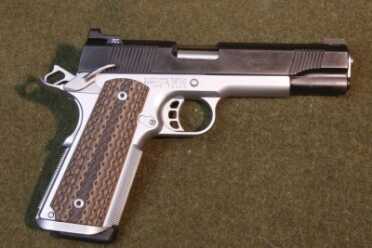
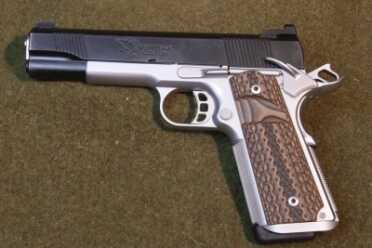
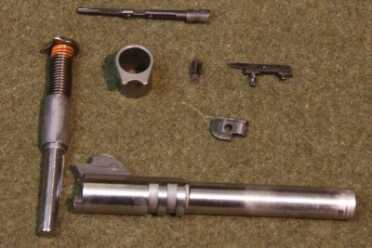
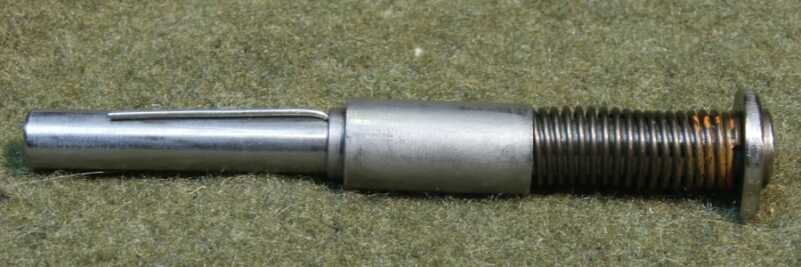
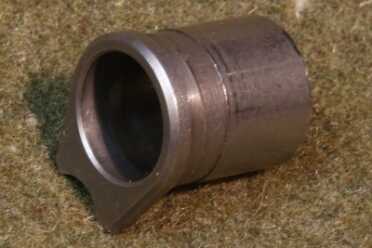
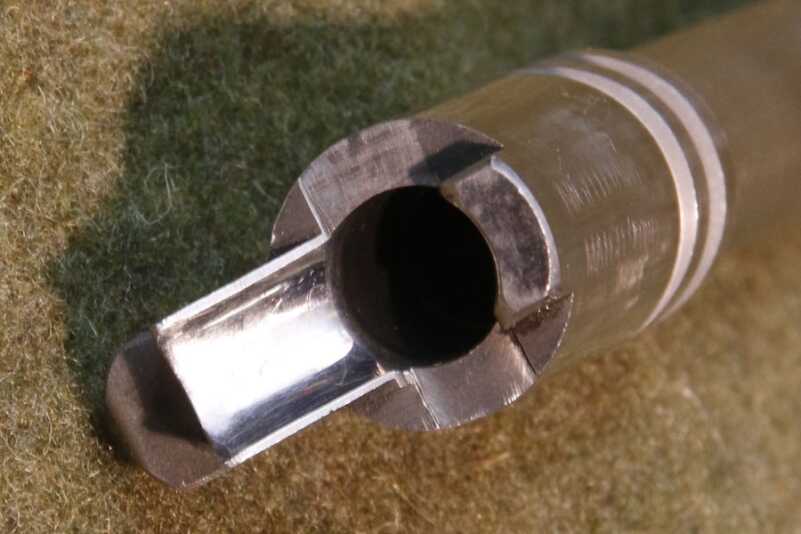
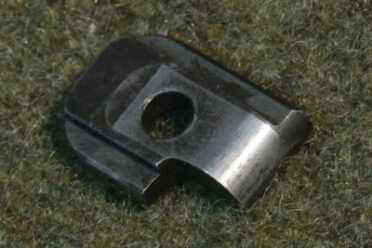
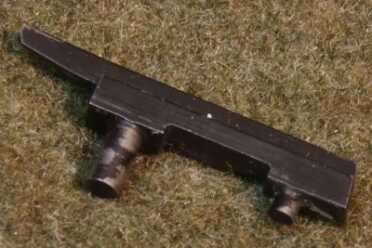
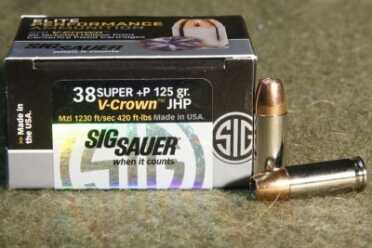
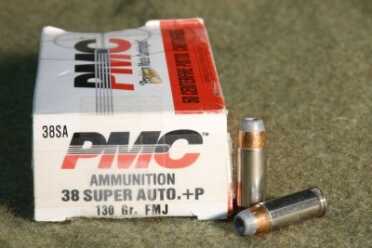
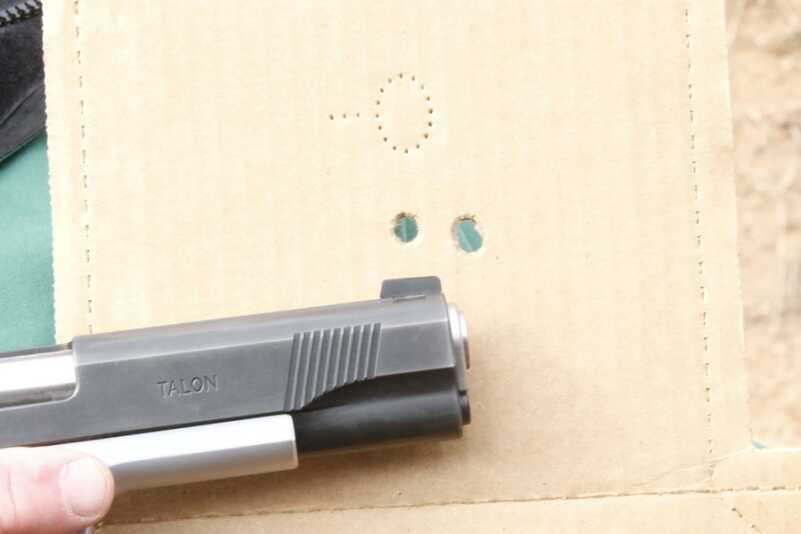


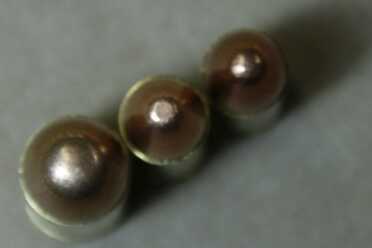
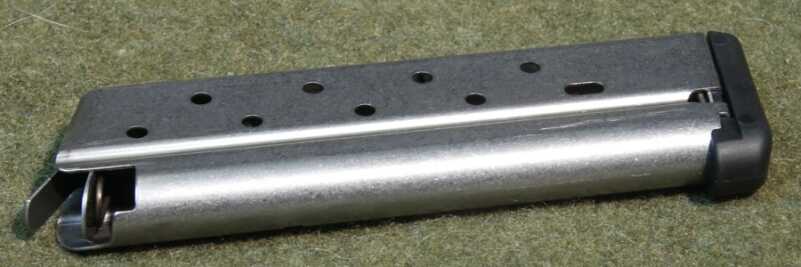
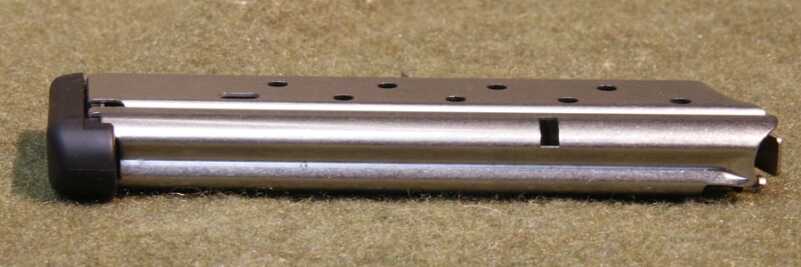
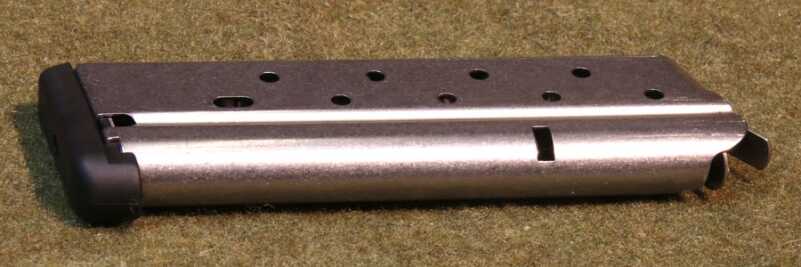
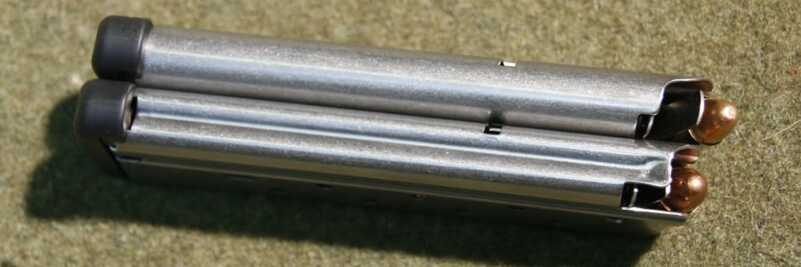
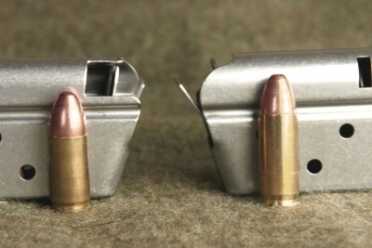
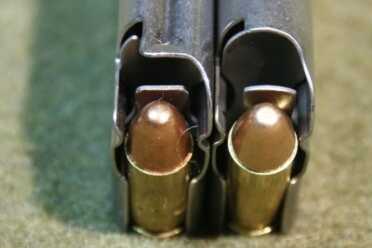
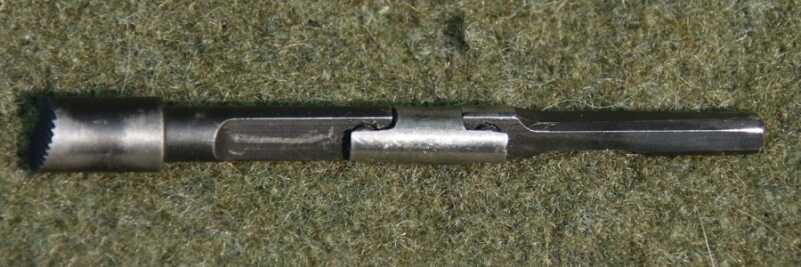
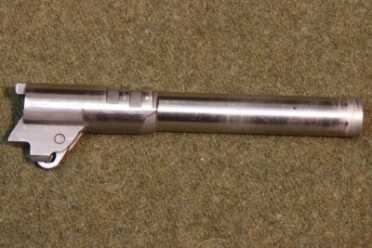
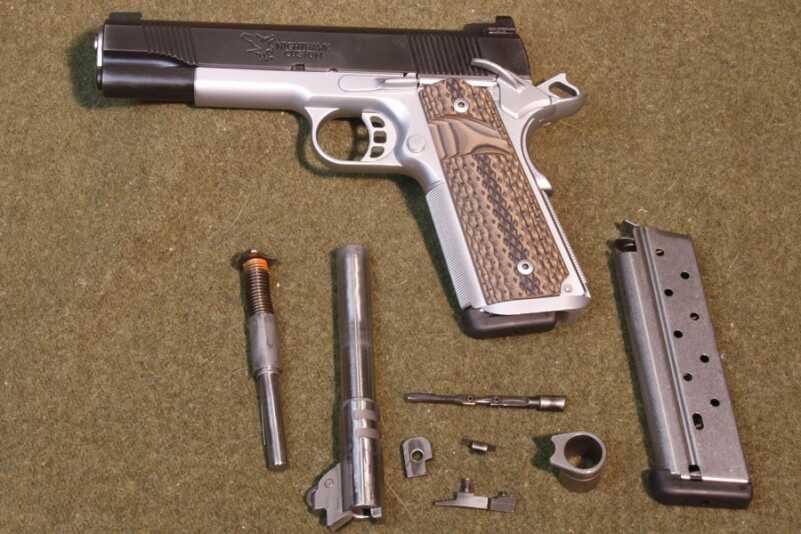
Did sig saur make a 1911 in a 38? I love sigs but 45 acp seems like it be a pretty big kick, especially since I’ve only had a 10mm glock and traded it in for a 9mm sig saur sp2022. (Which is the gun I currently have)
Idk i think a 9mm is the better caliber, doesn’t as much of a kick (but yet I here the weight of a 1911 brings down the kick for a 45 caliber) I imagine a 38 would be even better since its smaller then a 9 or 45. But I could be wrong.
.45 acp in 185 grn hp. Better than .38 super and more ideal for CC.
Comparing a lightweight 9mm projectile max 180 grain to a heavier .450 or 451 at 230 grains makes no sense.
38 super is good for many used although it wouldn’t be my woods gun, I wouldn’t turn one away for a fair price. It’s been in 1911s for a while now and if you want one, get it for that reason and not some gut who wrote an article said so.
I have a Colt 1911 .38 super with a four digit serial number that l got from my father in law who was a Michigan State Trooper. He wanted a 1911 but rules are rules and .45 was too big around for the Michiganders so old Bob decided on a .38 super. Best of both worlds. A sweet gun.
Hi Guys. I have a gold cup 38 super ,Colt had 5000 run in the 80 and mine is Sr,250 of that run. I sent it out to Mr. Clark and had
his barrel and comp installed. I competed for few years in IPSC, and WSSA, I want to sell it now but have no idea what its worth
today. Any body have any ideas as to what its worth.
Very cool article. Your side by side comparison with all three rounds left me thinking……..where is the 40 s&w round in the comparison?
If you did the conversion and used 38 Super Comp brass there would be no reason to switch out the extractor since the extractor and brass rim size are so similar to 9mm Brass.
Wow! $700 for a conversion??? Some guys just have to have that “custom” thing going on. I bought my Armscor .38 Super for less than $400, and it was the most accurate pistol I have ever shot right out of the box!
If feeds reliably, and I haven’t had a bit of trouble. My only regret is that I didn’t drop another $450 to get the nickel-plated version. I don’t see them listed so I assume Armscor dropped it from their product line.
38super was the dominate USPSA open division cartridge for many years. Old major power factor (175) required the cartridge push a 130gr projectile over a minimum 1346fps. Shopping for off the shelf .38super was kinda like shopping for off the shelf 10mm Auto ammo. It was drastically watered down.
This year was the first year it was published in front sight during 2015 USPSA nationals survey, the majority of shooters moved to the semi-rimmed .38super comp. It has the same dimensions, capacity, and everything as the 38super, however has a similar rim to that of a .223rem or .380acp. The purpose basically allows one extra round to be fitted into the 170mm magazine.
Converting 9×19 1911s to .38 Super is a fairly simple process and indeed does wonders for the reliability of the gun. My missus is a high-level USPSA competitor. She decided to go “minor” power factor for about a season and a half, as most female competitors do these days in USPSA.
Her sponsor/gunsmith simply converted her “IDPA” 9mm Springfield Loaded to .38 Super and we added a stack of Chip McCormick magazines. The gun ran absolutely perfectly with any kind of ammunition it was fed, which was almost entirely 130pf custom loads: loads tuned to just make the power floor comfortably, equaling a fairly strong 9×19 load.
The the builder made another new gun using a Springfield Range Officer 9mm slide and frame that was an all-out custom, with many handmade parts and some very unique features, built from the start in .38 Super.
It’s an unbelievable work of mechanical art that just so happens to function flawlessly and shoots with incredible accuracy.
It’s good to note that the original 9mm barrel and bushing can be dropped back in and then ordinary 9×19 can be used; however, the extractor tension, if set properly for .38, won’t be right for 9×19- the Super has a wider rim and needs less tension.
Still, most of the time it will run fine.
My 1951 Colt Commander Super has yet to bobble a round, shooting anything and everything that gets in the magazine. With CorBon DPX 125gr bullets departing at about 1240fps, it’s ballistically superior to pretty much any other .36 caliber handgun besides the .357. And you get 11 rounds with 1911 ergos and trigger.
I shouldn’t admit it, but it will also run plain 9mm ammunition just fine. Mechanically, that’s just wrong, but it works, and in a pinch, should ammunition run short, it can still be used with the vastly more common round.
One more thing about .38 Super: the brass has the extraordinary ability to de-molecularize upon firing- once it’s fired, it disappears from this universe, never to be found. Reloading .38 Super is the only good way to get best use of the caliber, but losing a large proportion of your brass will leave you scratching.
There are days I eye the .38 and wonder that it shouldn’t be in the holster where the .45’s always been.
Loved the story on the .38 super conversion; for the folks out there thinking about it for a carry gun, here is something else to consider: While the .38 super can be a very formidable round, I had an STI 2011 built up from parts I had won at various USPSA matches over the years that was basically a .38 super high-cap (18 rounds) that my gunsmith retuned the extractor on to handle rimless rounds. This allows me to use 9×23 winchester rounds in the gun, they run better than their .38super counterparts. So when I do carry that pistol it is stoked with 19 rounds of 9×23 winchester, easily a .357 magnum with 19 rounds……
Hey I love the .38 super also, but that is a lot of cash. I did the same thing, but got my parts on e bay. Barrel and bushing $85 bucks, a couple of metalform mags for 50.00 and boom of to the range. never a hiccup….We seem to get tied up on tight groups but in the end it’s all fun shooting…………..
Yeah, it’s definitely a more expensive route than I went through on the conversion of my 9×19 to .38 SUPER. I started with a mid-size RIA 9×19/.22TCM combo, so it was already setup to handle the .22TCM brass (which is based off .223 brass). My solution was to go with a .38 SUPER barrel while making my brass from cut-down .223 brass. Thus, no modifications would be necessary to the extractor. Since I’m loading the rounds at 9×23 level, I suspect that what I’ve actually created is a .38 SuperComp though. The existing bushing worked, so all I needed to purchase was the barrel and the recoil spring.
I have both 9mm and .38super on a 1911 platform I like the .38super better but the price of ammo makes me shoot the 9mm more. I too wonder why LEO never considered the .38super as a serious contender to the 9mm you get more bang along with more stopping power and very little noticeably recoil.
I really enjoyed this article about the .38 Super. I own three Colts, the oldest being previously owned by the Secret Service (in the 1930’s). I’d been hearing about this cartridge since the early 70’s, and finally got the opportunity to add the old Colt to my collection a few years back. I love the cartridge, and bought my son a Taurus PT-38S for home defense.
For $250 you could have a 7.62 Tokarev TTC, sure it’s different than the Nighthawk Custom 1911 Talon, but then you have 2 guns… just saying. I would take a 7.62×25 Tok over the 38 Super any day with 300 ft lb more energy than 9mm and 200 more than the 38 Super.
Nice sometimes to do these Conversions but the saying still applies.
” 45ACP, Because shooting twice is just Silly ”
Not to mention the availability or cost of 38 Super.
Myself the 45 and 9MM are available and very cheap and even in bad times will always be available thanks to Military and now many LE Depts. returning to the 9MM
What about the 7.62×25 Tokarev? Probably faster and more muzzle energy than the .30 Super. Wicked round.
tengo la colt 1911 en calibre . 38 super con el convertidor a .22 de fabrica y
para convertirla a 9mm la .38 solo se necesita cambiar cañon el cual tambien tengo